
Oct 08, 2013
- Products & Solutions
- Feature Story

Hello, everybody! This is Emi writing from Bangkok. Sometimes it seems like Thai summers last forever, but there are actually three seasons in Thailand. The dry season lasts from December to February and is comfortable with little rain. The hottest season, from March to April, is blazingly hot and also seldom rains. The rainy season from May to November is wet, hot and humid.
And here we are in the middle of the rainy season, when tropical fruit is ready to pick. You can see fruit sellers all over the city and I hear that a certain fruit seller is doing wonders with a Panasonic blender. Let's go visit the market and check it out!
Panasonic makes its products and technologies available to a diverse range of consumers around the world. These articles show some of the ways the company is changing lives in different cultures from the views of local reporters.

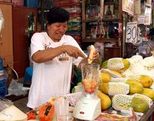
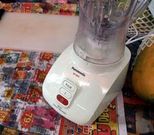
Khlongtoey Market is the largest farmers' market in Bangkok. Since the ground is usually drenched, the market is locally known as the "wet market" and "stomach of Bangkok". It stays open 24 hours a day and is illuminated all night in support of Thai eating habits. As I walk through the market, I find the fruit shop I was looking for - with a Panasonic blender in front. Seasonal tropical fruit covers the counter and Ms. Buakham, who runs the shop with her family, is blending away. She says, "Fruits are great when you eat them as they are, but blending them as juice makes it easier to enjoy more."
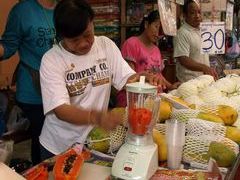
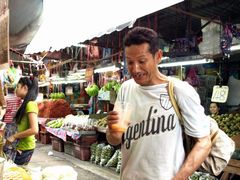
The pure papaya juice that Ms. Buakham makes is truly exquisite! But she has another recipe that's even better: She mixes the papaya with cantaloupe (a type of melon), coconut meat and coconut juice. Many people add water or ice to make juice easier to drink, but Ms. Buakham refuses to add a single drop since it would weaken the flavor. Instead, she uses coconut juice.
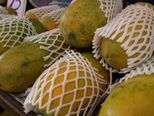
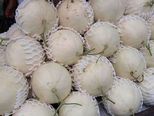
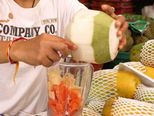
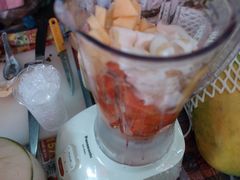
"Simply cut up fruit, drop it in and press the button. That's all it takes to create wonderfully tasty juice. The best thing about blending is that you can mix and match compatible fruit to create different flavors," says Ms. Buakham. She carefully scrapes coconut meat, which is commonly added to tapioca desserts, and drops the bits and pieces into the blender. As a fruit seller, she has a deep respect for fruit and scrapes every last drop.



Everyone Smiles While Enjoying Coconut Blends. Thank You, Ms. Buakham!
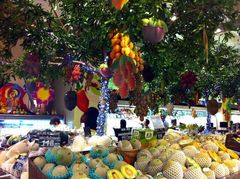
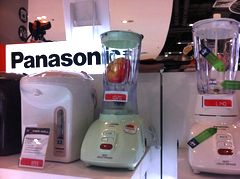
After the Khlongtoey Market, I head for a city supermarket. The prices, of course, are much higher than the market's, but the selection is just as dazzling. Fruit hangs decoratively from branches in the ceiling, indicating that this is the prime fruit season. In a corner stacked with durian, a popular Thai fruit, they are demonstrating how to deftly extract durian meat, which is a little too aromatic for my taste. Later, I step into the home appliances department and ask about blenders. The staff highly recommends the Panasonic model, which is available in two colors, because it is especially easy to use and maintain. When I ask if I can take a photograph, the salesperson smiles, steps back and very pleasantly says "please!" Truly, Thailand is the land of smiles.
Afterthought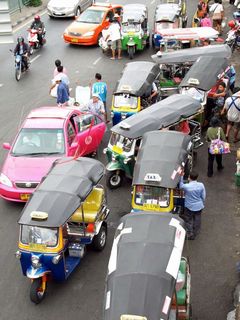
Thailand is 166% self-sufficient in grain, the highest rate for any nation in Asia (according to the Food and Agriculture Organization of the United Nations). In addition to having a rapidly growing economy, Thailand has always been a country rich in food. Since fruit is produced domestically, even mangos, which are expensive elsewhere, can be purchased for about one US dollar each, allowing anyone to afford eating as many as desired.
There is currently a booming health trend in Thailand, where people used to be satisfied with whatever food they were served. This trend to eat what is good for your health is replacing a recent trend to eat only what is tasty. Now more and more people are starting to cook for themselves because food stalls, which provide meals for a few dozen cents, typically serve food that is full of oil, sugar and salt. And this home cooking boom is driving a strong demand for home electrical appliances. As cooking appliances spread and become more advanced, they are accelerating the change in how Thai people eat.
(Reported by Emi)
The content in this website is accurate at the time of publication but may be subject to change without notice.
Please note therefore that these documents may not always contain the most up-to-date information.
Please note that German, French and Chinese versions are machine translations, so the quality and accuracy may vary.